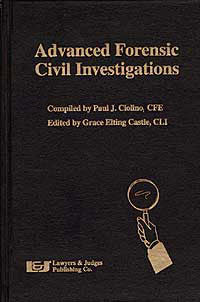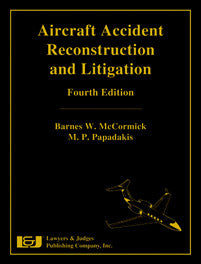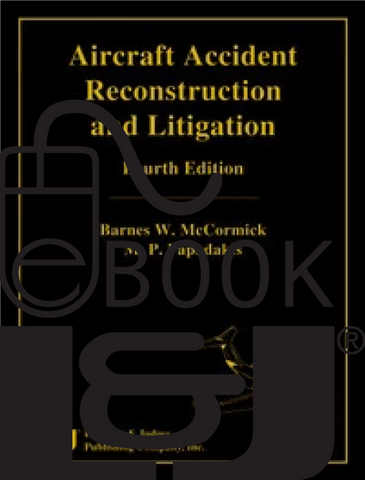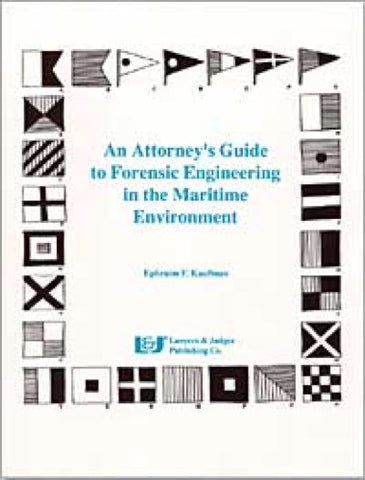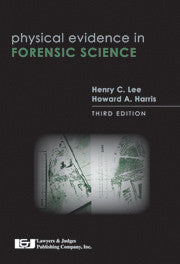
Physical Evidence in Forensic Science, Third Edition
- Author: Howard A. Harris, Henry C. Lee
- ISBN-10: 1-930056-01-X
- ISBN-13: 978-1-930056-01-5
- Copyright Date Ed: March 30, 2000
- Pages: 324
- Binding Information: Softcover
- Size: 6 ✕ 9 Inches (US)
This Third edition of the classic by America's leading forensic scientists gives you an insider's understanding of physical evidence at the crime scene.
Written in an easy-to-understand format, this outstanding guide, by the nation’s foremost forensic scientists, introduces you to the basics of crime scene evaluation. They teach you excellent ways to make your investigation solid and successful. This extensive resource is packed with valuable information about the details of collecting, storing, and analyzing all types of physical evidence. You’ll learn how to connect the victim(s) and suspect(s) to the crime scene, and to the physical evidence left behind. They also instruct you on how to use this information to provide convincing testimony based on scientific facts.
The book is divided into three parts plus appendices for easy access to the information you need. Part I offers an overview of forensic science and discusses the future path of forensic science and its applications in the courtroom and society. Part II gives you an exhaustive list of physical evidence typically left behind at crime scenes and explains the correct methods for processing this evidence. Part III discusses current issues in search and seizure, and how to effectively utilize it in court. The appendices discuss common blood screening test reagents and how to use the druggist’s fold for sealing evidence in paper.
This in-depth reference provides you with a wealth of details regarding many different topics including light, smoke, bullet identification, transient and pattern evidence, postmortem lividity marks and other special imprints and indentations, odors, wet versus dry blood samples, crime scene reconstruction techniques, and recognition and coordination of all elements of the crime scene during and after investigation.
This new edition of a classic is a must have for all crime scene investigators, law enforcement agencies, trial lawyers, and others involved in the investigative process.
This book is also available as an eBook. Click here to purchase and download:
Topics include:
- Introduction to forensic science
- Arson
- Bite marks
- Blood and body fluids
- Bombs and explosives
- Computers and electronic data as evidence
- Chemical substances
- Crime scene reconstruction
- DNA analyses
- Documents
- Drugs and controlled substances
- Firearms
- Fibers
- Fingerprints
- Glass
- Gunshot residue
- Hair
- Imprint and impression evidence
- Fingerprints
- Paints
- Pattern evidence
- Plastics
- Sexual assault and sex crime evidence
- Soil
- Tape
- Toolmarks
- Video evidence
- Voice identification
- Legal aspects of forensic science
- Some screening test reagents
- The druggist's fold
Table of Contents
Chapter 1: Physical Evidence in Forensic Science
1.1 Types of Physical Evidence at Crime Scenes
A. Transient Evidence
B. Pattern Evidence
C. Conditional Evidence
D. Trace and Transfer Evidence
E. Associative Evidence
1. Classification by type of crime
2. Classification by type of material
3. Classification by general nature of the evidence
4. Classification by the type of question to be resolved
5. Classification according to the way evidence was produced
6. Classification according to the specific type of evidence
1.2 Stages in the Analysis of Physical Evidence and Types of Interpretation
A. Recognition
B. Identification
C. Classification
D. Individualization
E. Reconstruction
1.3 Role of Physical Evidence in Investigation and Resolution of Criminal Activity
A. Information on the Corpus Delicti
B. Information on the Modus Operandi
C. Linking a Suspect with a Victim
D. Linking a Person to a Crime Scene
E. Disproving or Supporting a Witness’ Testimony
F. Identification of a Suspect
G. Providing Investigative Leads
H. Identification of a Substance
Chapter 2: Introduction to Forensic Science
2.1 Criminalistics
A. Forensic Drug Analysis
B. Forensic Chemistry
C. Analysis of Trace or Transfer Evidence
D. Firearms Examination
E. Latent Fingerprints
F. Forensic Serology
G. DNA Analysis
H. Impression Evidence
I. Questioned Document Examination
2.2 Other Forensic Science Specializations
A. Forensic Medicine
B. Forensic Anthropology
C. Forensic Odontology
D. Forensic Toxicology
E. Forensic Entomology
F. Forensic Engineering
G. Forensic Photography
H. Forensic Accounting
I. Digital Forensics (Computer Forensics)
Chapter 3: Reconstruction
3.1 Types of Reconstruction
3.2 Crime Scene and Laboratory Procedures
A. Recognition
B. Identification
C. Individualization
D. Evidence for Laboratory Submission
E. Crime Scene Examination
F. Reconstruction
3.3 Stages of Reconstruction
A. Data Collection
B. Conjecture
C. Hypothesis Formulation
D. Testing
E. Theory Formation
3.4 Team Concept in Reconstruction
Chapter 4: Arson and Fire Evidence
4.1 Nature and Types of Physical Evidence at Fire Scenes
A. Examination and Search of a Fire Scene
1. Documentation of the fire
2. Determination of the point of origin
3. Fire burn pattern interpretation
4. Other evidence
B. Examination for Accelerant Residue
4.2 Collection and Preservation of Fire Scene Evidence
A. Evidence Packaging
1. Metal cans
2. Glass jars
3. General guidelines
B. Collection of Fire Debris Evidence
1. Accelerant evidence
2. Other evidence
4.3 Laboratory Analysis of Fire Debris
A. Macroscopic Examination
B. Liquid Sample Analysis
1. Gas chromatography (GC)
2. Infrared spectroscopy
3. GC-IR or GC-MS
4. Determination of physical properties
5. Thin layer chromatography (TLC)
C. Solid Debris
1. Cold head space
2. Heated head space
3. Carbon tube or strip adsorption
4. Solvent extraction
Chapter 5: Bite Marks
5.1 Documentation and Collection of Bite Mark Evidence
A. Examination of the Bite Mark Area
B. Photographic Documentation
C. Swabbing the Bite Mark for Genetic Marker Testing
D. Collection of Bite Mark Impressions on Human Skin
E. Excision of Bite Marks
5.2 Analysis of Bite Mark Evidence
A. Tracing Using a Photographic Negative
B. Transparent Bite Mark Overlays
C. Wax Bite and Powder-type Amalgam Test
D. Direct Imprint of Tooth Marks on Human Skin
E. Transillumination of Bite Marks
F. Comparison of the Bite Mark with Known Samples
G. Enhancement through Digital Imaging Technique
Chapter 6: Blood
6.1 Collection of Blood Evidence
A. Clothing
B. Liquid Samples
C. Dried Bloodstains
D. Known Blood Standards
E. Blood Patterns
6.2 Field Tests for Blood (Chemical Screening Tests)
6.3 Laboratory Examination of Blood Evidence
A. Identification of Blood
1. Screening tests
2. Confirmatory tests
B. Species Tests
C. Blood Typing in Dried Bloodstains
1. Detection of ABO antibodies in serum (Lattes test)
2. Detection of blood group antigens
6.4 AIDS and Other Biohazards in Crime Scene Processing and Law Enforcement
A. Biohazards
1. AIDS
2. Hepatitis
3. Other blood and body fluid-borne infectious agents
B. General Precautionary Measures
C. Specific Guidelines for Crime Scene Investigators
Chapter 7: Body Fluids Other Than Blood
7.1 Collection and Preservation of Evidence
A. Clothing
B. Known Samples Collected from Victim or Suspect
1. Known saliva and DNA standards
2. Urine and/or fecal material
3. Vaginal materials
4. Nasal mucous
C. Body Fluids or Tissues on Other Items
1. Foreign objects
2. Saliva
3. Bite mark evidence
4. Skin tissue
7.2 Laboratory Examination of Body Fluids
A. Identification
1. Saliva
2. Urine
3. Fecal material
4. Gastric fluid
5. Perspiration
6. Epithelial cells and tissues
B. Classification or Individualization
1. ABO blood group substances
2. Isoenzymes
3. DNA testing
Chapter 8: Bombs and Explosives
8.1 Types of Explosives
A. Low Explosives
B. Primary High Explosives (Primer)
C. Secondary High Explosives
D. Improvised Explosive Devices (IEDs)
8.2 Collection of Explosives Evidence
A. Location of the Origin of the Blast
B. Documentation
C. Collection of Physical Evidence
D. Safety Considerations
E. Packaging
8.3 Laboratory Analysis of Explosives
A. Macroscopic Examination
B. Microscopic Examination
C. Extraction
D. Chemical Tests
1. Chemical color tests
2. Microcrystal tests
E. Thin Layer Chromatography
F. Instrumental Analysis
1. Organic components
2. Inorganic components
3. Chromatography and Spectroscopy
G. Explosives Tagging Program
Chapter 9: Chemical Substances
9.1 Nature of Chemical Evidence
A. Types of Chemical Evidence
1. Gas
2. Liquid
3. Solid
B. Field Tests
9.2 Collection of Chemical Evidence
A. General Considerations
B. Packaging of Chemical Evidence
1. Packaged chemicals
2. Containers
3. Clothing
9.3 Laboratory Analysis of an Unknown Chemical
A. Preliminary Examination
1. Physical state
2. Microscopic examination
B. Chemical Tests
1. Solubility
2. Microchemical analysis
3. Chromatography—Separation Techniques
C. Instrumental Techniques
1. Infrared spectroscopy
2. Ultraviolet (UV) and visible spectroscopy
3. Mass spectrometry (MS)
4. Scanning electron microscope (SEM)
Chapter 10: Digital and Multimedia Evidence (Digital Forensics)
10.1 Collection of Computer Evidence
10.2 Processing of the Digital Evidence
10.3 Some Other Digital and Analog Devices
Chapter 11: DNA Analysis
11.1 Nature of DNA Analysis
A. Deoxyribonucleic Acid (DNA)
B. Types of DNA Analysis
1. Restriction fragment length polymorphism (RFLP)
2. Polymerase chain reaction (PCR)
11.2 Collection and Preservation of Evidence for DNA Analysis
A. Evidence Suitable for DNA Analysis
B. Collection of Biological Evidence
1. Documentation of evidence
2. Collection methods
11.3 Laboratory Analysis of DNA Evidence
A. RFLP Analysis
1. Some terms used in describing RFLP analysis
2. Forensic RFLP analysis
B. Polymerase Chain Reaction (PCR)
1. Basis of PCR analysis methods
2. Sex determination by STR
3. Y-STR Analysis
4. Mitochondrial DNA (mtDNA)
5. Non-human DNA
Chapter 12: Questioned Document Examination
12.1 Types of Document Evidence Examinations
A. Handwriting Comparisons
B. Comparison of Writing Materials
C. Determination if a Document Has Been Altered
D. Determination of Common Origin or “Authorship”
E. Reconstruction
12.2 Collection and Preservation of Document Evidence
A. Questioned Evidence Samples
B. Requested Known Standards (Often Subject to Court Order)
12.3 Laboratory Examination of Document Evidence
A. Analysis of Writing Materials
B. Handwriting Analysis
C. Typewriting and Printer Analysis
D. Alterations
E. Printing and Photocopying
F. Indented Writing
G. Charred Documents
H. Determination of Document Age
I. Visible Microspectrophotometry
J. Video Spectral Comparator (VSC)
K. Image Enhancement
Chapter 13: Drugs and Controlled Substances
13.1 Types of Drug Evidence
A. Definition
B. Classification of Forensic Drug Evidence
1. Opiates (analgesics)
2. Stimulants
3. Hallucinogens
4. Depressants
5. Athletic performance enhancers
13.2 Collection of Drug Evidence
A. Blood Samples
B. Urine Samples
C. Plant Material
D. Powders, Tablets, and Capsules
E. Drug Paraphernalia
13.3 Investigation of Clandestine Laboratories
A. General Guidelines
B. Safety Guidelines
1. Chemical hazards
2. Biological hazards
C. Chemicals
13.4 Laboratory Examination of Drug Evidence
A. Macroscopic Analysis
B. Chemical Tests
C. Microscopic Analysis
1. Microscopic examination of seized materials
2. Microcrystal tests
D. Thin Layer Chromatography
E. Instrumental Analysis
1. Infrared spectroscopy (IR)
2. Gas chromatography-mass spectrometry (GC-MS)
3. High performance liquid chromatography (HPLC)
Chapter 14: Fibers
14.1 Nature of Fiber Evidence
A. Natural Fibers
B. Synthetic Fibers
C. Derived or Regenerated Fibers
14.2 Collection and Preservation of Fiber Evidence
A. Manual Collection
B. Vacuum
C. Tape Lift
D. Mechanical Dislodgment
E. Packaging Fiber Evidence
1. Material recovered from vacuum processing
2. Individual fibers
3. Other fiber evidence
14.3 Laboratory Examination of Fibers
A. Physical Match
B. Microscopic Examination
C. Microchemical Tests
D. Determination of Physical Properties
E. Polarized Light Microscopy
F. Instrumental Methods
Chapter 15: Fingerprints
15.1 Nature and Classification of Fingerprint Patterns
A. Fingerprint Patterns
1. Loop
2. Arch
3. Whorl
B. Types of Fingerprints
1. Inked fingerprints
2. Visible (patent) prints
3. Plastic prints
4. Latent prints
15.2 Collection and Preservation of Fingerprint Evidence
A. Dusting of Nonporous Surfaces
B. Alternate Processing Methods
1. The “super glue wand” for cyanoacrylate fuming
2. Alternate light source
C. General Recommendations
D. Collection of Fingerprint Evidence Not Processed at the Scene
1. Items transported to the laboratory
2. Post-mortem fingerprints
15.3 Laboratory Examination of Latent Prints Evidence
A. Processing of Physical Evidence for Latent Fingerprints
1. Powder dusting
2. Iodine fuming
3. Ninhydrin and ninhydrin analogues
4. Physical Developer
5. Fluorescent reagents
6. “Super glue” method
7. Alternate processing methods
B. Development of Latent Prints on Skin
1. Iodine-silver method
2. Cyanoacrylate fuming and laser/alternative light source detection
3. Decomposed bodies
C. Comparison of Fingerprints
D. Fingerprint Classification Systems
E. Automated Fingerprint Identification Systems (AFIS)
1. Types of AFIS systems
2. Use of AFIS
Chapter 16: Firearms
16.1 The Nature of Firearms Evidence
A. Barrel
1. Rifled barrel
2. Smooth-bore barrel
3. Caliber
B. Components of the Firing Mechanism
C. Ammunition (See Figure 16.1)
1. Projectiles
2. Jacket
3. Cartridge case
4. Primer
5. Powder
16.2 Collection of Firearms Evidence
A. Documentation
B. Collection of Weapons
C. Collection of Bullets and Cartridge Cases
D. Evidence Requiring Special Handling
1. Loaded firearms
2. Weapons in water
3. Bullets
4. Firearm adjustment or testing
16.3 Laboratory Examination of Firearms Evidence
A. Information Obtained from Firearms Evidence (See Table 16.1)
B. Examination for Identification (Individualization)
1. Bullet comparisons
2. Cartridge case comparisons
Chapter 17: Glass
17.1 Nature of Glass Evidence
A. Stability
B. Composition
C. Patterns
17.2 Documentation and Collection of Glass Evidence
A. Documentation of Glass Fracture Patterns
B. Reconstruction of Glass Evidence
C. Collection of Glass Evidence
17.3 Laboratory Analysis of Glass Evidence
A. Types of Examinations Conducted
B. Methods of Examinations
1. Macroscopic examination
2. Physical match
3. Glass chemical and physical properties
C. Glass Fracture Patterns
1. Determination of the direction of force
2. Determination of the sequence of multiple fractures
3. Direction of travel of the break
Chapter 18: Gunshot Residue
18.1 Source of Gunshot Residue
A. Primer
B. Propellant (Powder)
1. Black powder
2. Smokeless powder (virtually all modern cartridges use
smokeless powder)
C. Lubricants
D. Metallic Materials
18.2 Collection of Gunshot Residue
A. GSR Collection Kits
1. Adhesive discs
2. Swabs
B. Gunshot Residue on Other Items of Evidence
18.3 Laboratory Analysis of Gunshot Residue
A. Microscopic Analysis
B. Chemical Tests for Nitrates and Nitrites
C. Detection of Primer Residues
1. Microchemical tests
2. Atomic absorption (AA) or Inductively Coupled Plasma (ICP)
Spectroscopic techniques
3. Scanning electron microscope/energy dispersive x-ray analysis
(SEM-EDX)
4. Neutron activation analysis (NAA)
5. Gas chromatography/mass spectrometer (GC/MS)
6. High performance liquid chromatography (HPLC)
7. Micellar electrokinetic capillary electrophoresis (MECE)
D. GSR Pattern Analysis
1. Direct contact
2. Close range (1–6 inches)
3. Medium range (1-1/2 to 4 feet)
4. Long range (greater than 4 feet)
5. Use of Greiss reagent and sodium rhodizinate reagent
Chapter 19: Hair
19.1 Characteristics of Hairs
A. Nature of Hair
B. Microscopic Characteristics of Hair
1. Cuticle
2. Medulla
3. Cortex
19.2 Collection and Preservation of Hair Evidence
A. Collection of Evidentiary Hair Samples
B. Collection of Known Hair Standards
19.3 Laboratory Examination and Comparison of Hairs
A. Identification
B. Microscopic Examination and Comparison of Hairs
C. Instrumental Techniques
1. Neutron activation analysis (NAA)
2. Pyrolysis GC
D. Genetic Markers in Hairs
1. ABO grouping of hair
2. Sexing of hair
3. DNA analysis
Chapter 20: Imprint and Impression Evidence
20.1 Nature of Imprint and Impression Evidence
A. Imprint (Residue) Prints
B. Impression Prints
20.2 Collection and Preservation of Imprint or Impression Evidence
A. Documentation of Imprint and Impression Evidence
B. Collection of Residue Imprint Evidence
1. Movable or removable objects
2. Large items or immovable evidence
C. Collection of Impression Evidence
D. Collection of Known Standards
1. Shoes
2. Tires
20.3 Laboratory Analysis of Imprint and Impression Evidence
A. Determination of Class Characteristics
B. Determination of Individual Characteristics
C. Comparison of Imprints or Impressions with Known Patterns
Chapter 21: Paint Evidence
21.1 Nature of Paint Evidence
A. Definition of Paints
B. Classification of Paints
C. Pigment Classification
21.2 Collection of Paint Evidence
A. Paint on Large Objects or a Vehicle
B. Small Items of Physical Evidence
1. Paint chip evidence
2. Garments
3. Tools
4. Projectiles
5. Paint smear evidence
C. Cases When No Suspect Vehicle is Available
21.3 Laboratory Analysis of Paints and Coatings
A. Macroscopic Analysis
1. Physical characteristics
2. Layer structure
3. Control samples
B. Physical Match of Paint Chips
C. Microscopic Examination
1. Layer structure
2. Further testing
D. Microchemical tests
1. Type of tests
2. Chemical properties
E. Instrumental Methods
1. Microscopic-FTIR
2. SEM-EDX
3. Visible microspectrophotometry
Chapter 22: Pattern Evidence
22.1 Pattern Evidence and Interpretations
A. Bloodstain Patterns
B. Glass Fracture Patterns
C. Fire Burn Patterns
D. Furniture Position Patterns
E. Projectile Trajectory Patterns
F. Track-trail Patterns
G. Tire and Skid Mark Patterns
H. Modus Operandi Patterns
I. Clothing or Object Distribution Patterns
J. Gun Powder Residue Patterns
K. Material Damage Patterns
L. Body Position Patterns
22.2 Documentation of Pattern Evidence
A. Recognition and Documentation
B. Interpretation
22.3 Collection of Pattern Evidence
A. Patterns on Movable Objects
B. Patterns on Immovable Objects
C. Preliminary Interpretation of Pattern Evidence
Chapter 23: Plastics
23.1 Nature of Plastics
A. Definition of Plastics
B. Types of Plastic Evidence
23.2 Collection of Plastic Evidence
A. Packaging
B. Other Evidence
23.3 Laboratory Examination of Plastics
A. Physical Match
B. Macroscopic Analysis
C. Microscopic Examination of Striations
D. Microchemical Solubility and Color Tests
E. Instrumental Analysis
Chapter 24: Semen
24.1 Nature of Semen Evidence
A. Cellular Components
B. Seminal Fluid
1. Testis
2. Prostate gland
3. Seminal vesicles
4. Cowper’s glands
24.2 Collection of Evidence Containing Semen
A. Clothing
B. Sexual Assault Evidence Kit
C. Condoms
D. Liquid Semen
E. Large Items of Physical Evidence
24.3 Laboratory Examination of Semen Evidence
A. Macroscopic Examination
B. Chemical Tests
C. Confirmatory Tests for Semen
1. Microscopic
2. Human seminal fluid protein (p30)
D. ABH Antigenic (Blood Group) Substances
E. DNA Testing
Chapter 25: Serial Number Restoration
25.1 Collection of Evidence
A. Nature of Evidence
B. Packaging
25.2 Laboratory Restoration of Obliterated Serial Numbers
A. Methods of Restoration
1. Chemical restoration
2. Electrolytic method
B. Results
Chapter 26: Soil
26.1 Nature of Soil
A. Inorganic Materials
B. Organic Matter
C. Man-made Materials
26.2 Collection of Soil and Dust Samples
A. Documentation
B. Collection and Packaging
C. Impression Evidence
D. Soil on Clothing
E. Larger Evidence
26.3 Laboratory Analysis of Soil
A. Macroscopic Examination
B. Initial Comparison
C. Separation of Soil Components
D. Density
E. Particle Size Distribution
F. Instrumental Analysis
Chapter 27: Tape
27.1 Nature of Tape Evidence
A. Ribbon
B. Adhesive
27.2 Collection of Tape Evidence
27.3 Laboratory Examination of Tapes
A. Trace Materials
B. Physical Match
C. Macroscopic Examination
D. Microscopic Examination
E. Chemical Properties
F. Instrumental Analysis
1. Fourier transform infrared spectroscopy (FTIR)
2. Pyrolysis GC
3. SEM/EDX
Chapter 28: Toolmarks
28.1 Nature of Toolmark Evidence
A. Compression Toolmarks
B. Sliding Toolmarks
28.2 Documentation and Collection of Toolmarks
A. Photo Documentation
B. Written Documentation
C. Marking Toolmark Evidence
D. Trace Evidence
E. Collection of Toolmark Evidence
1. Small items of evidence
2. Large or immovable items
28.3 Laboratory Analysis of Toolmark Evidence
A. Class Characteristics
B. Comparison of Individual Markings
Chapter 29: Voice Identification
29.1 Principle of Voice Analysis
A. Voice Characteristics
B. Voice Spectrograms
29.2 Collection of Audio Samples
A. Questioned Samples
B. Known Samples
29.3 Laboratory Comparison of Recordings and Spectrograms
Chapter 30: Proper Seizure of Evidence for Effective Utilization in Court
30.1 Introduction
30.2 When Does the Fourth Amendment Apply?
A. The Fourth Amendment
B. Reasonable Expectation of Privacy
C. Abandoned Property
D. Importance of Knowing When the Fourth Amendment Applies
E. Sanction for Failing to Comply with the Fourth Amendment
30.3 Situations When a Search Can Be Performed Without a Warrant
A. Consent
B. Exigency
1. Fire scene searches
2. Other crime scene searches
C. Automobile Exception
D. Inventory Searches
E. Plain View
F. Search Incident to Custodial Arrest—Stationhouse Searches
G. Caretaking Search
H. Stop and Frisk
30.4 Search Warrant Must Particularize the Items the Investigator is Requesting Permission to Seize
A. Description of Things to Be Seized
B. Examples of Particularizing Items
1. Items from a fire scene
2. Examples of Mincey warrant items
30.5 Effect of Daubert versus Merrill-Dow
30.6 Professional Handling of Evidence
A. Documentation of the Chain of Evidence
B. Packaging of Evidence
30.7 Conclusion
Appendix A: Preparation of Common Test Reagents
A.1 Blood Screening Test Reagents
A.2 Acid Phosphatase Reagents
A.3 Bloody Print Enhancement Reagent
Appendix B: The Druggist Fold

